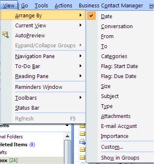Top tips to reduce email overload. Let’s Talk Business – radio interview with Alan Coote. (about 1 minute 20 secs into the broadcast).
Tags: email best practice, email management training, email overload
Outlook – here are ten top time saving functions. They are based on Outlook 2007 to 2013 and Outlook 365. Using Outlook can also help you reduce email overload by filtering emails you do not need to see in your main inbox (eg using rules and views).
For OL 2013 onwards go to File/Options/Mail. Then untick all the boxes in the Message arrival Pane.

[For OL pre 2013 go to Tools/Options. From the Preferences tab, click on the Email Options button/Advanced email options. Remove the tick in all the boxes in the panel marked ‘When new items arrive in my inbox’.]
Drag and drop the email from the inbox on either the Task or the Calendar icon.
3) Rules
To create a simple rule, right click on the email, select Create Rule and complete the Create Rule box.

 For more complex rules go to Tools/Rules and Alerts and use the Rules Wizard. Select the type of rule and then complete Stage 2 by clicking on the hyperlinked phrases eg people.
For more complex rules go to Tools/Rules and Alerts and use the Rules Wizard. Select the type of rule and then complete Stage 2 by clicking on the hyperlinked phrases eg people.
 Click on an email from the person whose emails you want to highlight. Go to Tools/Organize. In the Ways to Organize Inbox dialogue box click on Using Colors.
Click on an email from the person whose emails you want to highlight. Go to Tools/Organize. In the Ways to Organize Inbox dialogue box click on Using Colors.
In 2013 Color has been omitted and instead Categories should be used.
To save and re-use templates of frequently used text, type the text in a new email. Highlight it and click on Insert/Quick Parts/Save Selection to Quick Parts Gallery. From the drop down menu pick Save.

The text is then saved and can be reused in future emails. To insert the text in a new email, click in the message area and go to Insert/Quick Parts and select the required text.
Use the Reading Pane or AutoPreview to scan quickly the content of an email. They can be set for each folder (ie on or off).
You can customise how you see your Inbox and each folder using the View menu.
Arrange By allows you to group emails, eg by Date, Subject, Sender etc. View/Arrange By and select the criteria eg From and click on Show in Groups.

Click on the Categories icon and click on the one you want.

To edit the default list, pick All Categories (at the end of the list). Click on New and give category a name and select a colour by opening the Color dropdown menu.

With a new email open, click on the Options tab and select Voting buttons.

For 2003 select the Options menu. From the Options dialogues box select Voting buttons.
Click on the down arrow at the bottom right of the More Options menu. For 2003 proceed as above and pick Expiry date from the Options dialogue box.
If you like these tips, why not come on one of our email management training session and learn more ways to save time and reduce your email overload. Alternatively, read Brilliant Email.
Tags: Briliant Email, email management training, email overload, Outlook, Outlook 2007
Do you feel emails and social media are taking over your life? According to a University of California, Irvine and US Army Researchers, people who check their work email regularly exhibit higher states of ‘alertness’ and less focus than they do if they are cut off from email entirely.

Email overload heartbeat
Heart rate monitors were attached to computer users in a suburban office setting, while software sensors detected how often the users switched windows. People who read email, changed screens twice as often and were in a continuous “high alert” state, with more constant heart rates. Those removed from email for five days experienced more natural, variable heart rates but reported feeling isolated from on-going information.
Some suggestions to reduce these unwanted health effects could be:
Investor Harj Taggar weaned himself off email on his phone, and noticed a marked improvement in his concentration as a result. Independent research has also found that a large percentage of email adds little value to the individual’s or the organisation’s day.
When Thierry Breton, CEO and chairman of Atos, announced they would be phasing out internal email altogether, it was considered radical, but it has subsequently been shown to be a move in the right direction by Atos Consulting’s own research on workplace well-being and performance.
In one week, 300 people in Atos Consulting sent or received 85,000 messages. The majority of employees found the volume of email unmanageable and many of the messages unimportant.
One in four managers claimed to spend more than 25% of their time writing emails that add no value to their work. Simply reading these messages can swallow up 28% of time in a working day.
The research concluded – At best, they are a “productivity drain”, at worst, they result in under performance and employee disengagement.
If you can’t go that far you could try:
Email often results in mis-communication, as intonation and body language are missing from the communication. My own personal experience reinforces this and I find a quick telephone chat can enhance rapport and clarify meanings or talking directly to a colleague if they are in the same room/building is useful and may involve a little walking exercise. Email is not a substitute for basic conversation with all the nuances you get from face to face interaction.
Constantly checking emails and social media removes an individual from contact with those around them and in a one-to-one or group situation, makes friends/colleagues feel secondary to the unknown person on the end of a smart phone or tablet.
We cannot ignore 21st century communication but we CAN choose how we use it, ensuring balanced mental health and well-being.
Ann McCracken is Director of AMC2 and Vice President ISMAUK. She is author of ‘The Stress Gremlins’. This originally appeared on on www.amc2.co.uk.
If either you or anyone in your organisation is suffering with stress ask us about how our Brilliant Workshop can hep you and your staff take control of your inbox and your day.
Tags: email management training, email overload, email stress, wellbeing
Radio interview with Alan Coote of Lets Talk Business
Lets Talk Business On-line January 2013
Tags: email management training, email overload, future of email

Empty Wardrobe – Empty Inbox
2012 saw the volume for email traffic rise by at least 10% and certainly my inbox is starting to bulge again. Email overload is rising (and hence email stress its direct descendant). Do I declare inbox bankruptcy like so many before me. The only trouble is that unlike a bank there is no bale out if I lose a valuable email. Yesterday I spent four hours clearing out my sent items and lots of old folders. It felt just like clearing out the wardrobe of all those old clothes which one hangs onto just in case either they come back into fashion or you lose some weight so once more you can get into those skinny fit jeans!
In the case of the inbox it was old projects and possible joint ventures which had long since past their sell by date.
As a result here are my top tips and indeed my own goals for limiting the effects of email overload and email induced stress.
What are your goals and plans for 2013 to help you save time and unchain yourself from the inbox?
Do you need some help slimming down your inbox for 2013? Call us and we can discuss how our Brilliant Email Management workshops and coaching can help you and your business. Alternatively, subscribe to our free monthly e-briefing.
Tags: Brilliant Email, Email Bankruptcy, email management training, email overload, email stress, empty inbox, Imrpoved personal productivity, new year's resolutions